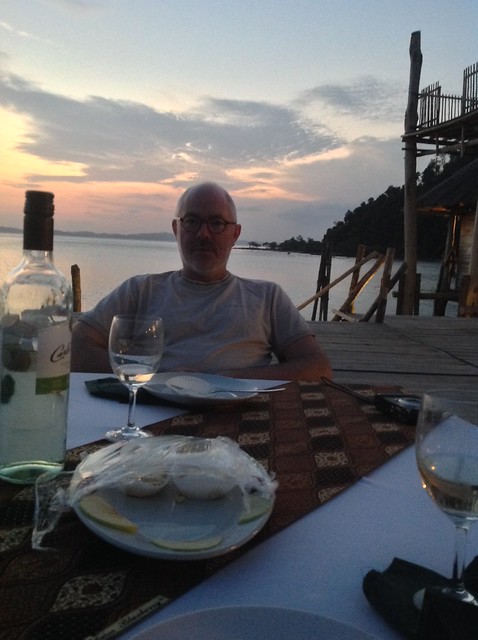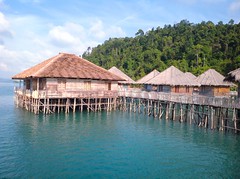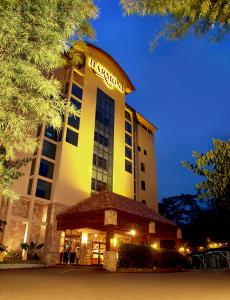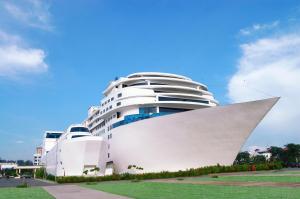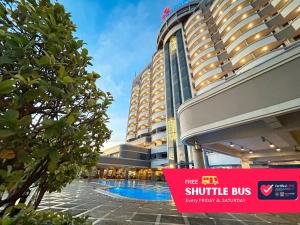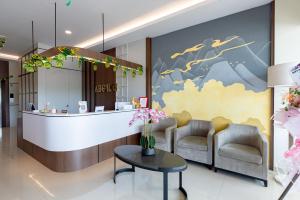Riau Islands
The Riau Islands (Indonesian: Kepulauan Riau) is a province of Indonesia. It comprises a total of 1,796 islands scattered between Sumatra, Malay Peninsula, and Borneo including the Riau Archipelago. Situated on one of the world's busiest shipping lanes along the Malacca Strait and the South China Sea, the province shares water borders with neighboring countries such as Singapore, Malaysia, and Brunei. The Riau Islands also have relatively large potential mineral resources and energy, as well as marine resources. The capital of the province is Tanjung Pinang and the largest city is Batam.
The Riau archipelago was once part of the Johor Sultanate, which was later partitioned between the Dutch East Indies and British Malaya after the Anglo-Dutch Treaty of 1824, in which the archipelago fell under Dutch influence. A Dutch protectorate, the Riau-Lingga Sultanate, was established in the region between 1824 and 1911 before being directly ruled by the Dutch East Indies. The archipelago became a part of Indonesia following the occupation of the Japanese Empire (1942–1945) and the Indonesian National Revolution (1945–1949). The Riau Islands separated from the province of Riau in September 2002, becoming Indonesia's third-youngest province.
A free trade zone of the Indonesia–Malaysia–Singapore Growth Triangle, the Riau Islands has experienced rapid industrialisation since the 1970s. The Riau Islands is one of the country's most prosperous provinces, having a GDP per capita of as of 2011, the fourth highest among all provinces in Indonesia after East Kalimantan, Jakarta and Riau. In addition, as of 2018, the Riau Islands has a Human Development Index of 0.748, also the fourth highest among all provinces in Indonesia after Jakarta, Special Region of Yogyakarta and East Kalimantan.
The population of the Riau Islands is heterogeneous and is highly diverse in ethnicity, culture, language and religion. The province is home to different ethnic groups such as the Malays, Tionghoa, Javanese, Minangkabau and others. Economic rise in the region has attracted many immigrants and labors from other parts of Indonesia. The area around Batam is also home to many expatriates from different countries. Approximately 80% of these are from other Asian countries, with most of the westerners coming from the United Kingdom, rest of Europe, as well as Australia and the United States. The province also has the second largest number of foreign tourist arrivals in Indonesia, after Bali.
History
Etymology
There are several possible origins of the word riau. The first possible origins is that riau is derived from the Portuguese word rio, which means river. After the fall of the Malacca Sultanate in the early 16th century, the remaining Malaccan nobles and subjects fled from Malacca to mainland Sumatra while being pursued by the Portuguese. The Portuguese is believed to have reached as far as the Siak River.
The second version claims that riau comes from the word riahi which means sea water. The word is allegedly derived from the figure of Sinbad al-Bahar in the book of the One Thousand and One Nights.
Another version is that riau is derived from the Malay word riuh, which means crowded, frenzied working people. This word is believed used to reflect the nature of the Malay people in present-day Bintan. The name is likely to have become famous since Raja Kecil moved the Malay kingdom center from Johor to Ulu Riau in 1719. This name was used as one of the four main sultanates that formed the kingdoms of Riau, Lingga, Johor and Pahang. However, as the consequences of the Anglo-Dutch Treaty of 1824 between the Netherlands and United Kingdom, the Johor-Pahang sultanates fell under British influence, while the Riau-Lingga sultanates fell under Dutch influence.
Pre-sultanate era
Riau has for centuries been the home of Malay and Orang Laut people (sea nomads). Later migrants came from southern China and Indochina, today people from a large region of Asia has settled on the Islands. The Riau archipelago is located between the China-India maritime trading route, and was early in the 14th century, together with Temasek (Singapore). Chinese maritime records one of Riau archipelago's islands was inhabited by Malay pirates.
As many as three hundred ships were used to force Chinese ships returning from the Indian Ocean into pirate harbors and to attack those who resisted. Large quantities of Chinese ceramics have been recovered on Bintan, some date back to the early Song dynasty (960–1127). An Arabian explorer, Ibnu Battuta, wrote about Riau in the 13th century: "Here there are little islands, from which armed black pirates with poised arrows emerged, possessing armed warships; they plunder people but do not enslave them." Log records of Chinese ships testify these incidents in the 12th century. Even after several centuries, the Riau archipelago, especially Bintan, is still referred to as the "Pirate Island".
During the 12th to 13th century, the Riau archipelago was a part of the Srivijaya Empire. Sri Tri Buana, a member of the royal family of Palembang, visited Riau in 1290. The Queen of Bintan met him, and he combined flotilla of 800 vessels sailed for Bintan where he later became a king. It is also said that it was he who gave name to Singapore. Upon landing on Temasek, the old name of Singapore, he spotted an animal, which he thought was a lion, and renamed Temasek as Singapura (Lion City). He also proclaimed himself as a king of Singapore.
According to the Malay Annals, a Srivijaya prince named Seri Teri Buana, fleeing from the sacking of Palembang, stayed on Bintan for several years, gathering his strength before founding the Kingdom of Singapura (Singapore).
Sultanate era
During the rule of Sultan Mansur Shah (1459–1466), the Riau archipelago became part of the Malacca Sultanate. The fall of Malacca Empire in 1511 when Malacca fell to the Portuguese. Sultan Mahmud Shah fled to Pahang and then to Johor and Bintan in 1521. There, he held out against Portuguese attacks, he even laid siege on Malacca in 1524, before a Portuguese counterattack forced him to flee to Sumatra where he died in 1528. Sultan Alauddin succeeded his father and set up a new capital in the south. The archipelago became the part of the "war triangle" between the Portuguese, the Johor Sultanate and the Acheh Sultanate of northern Sumatra.
Bintan saw many rulers during the time, as the three countries grew and declined in power. Subsequently, the Portuguese attacked Johor in 1587. The Siege of Johor, resulted in a Portuguese victory. The forces of Johor were unable to prevent the heavy Portuguese infantry from landing and storming the city after a naval bombardment, its Sultan was forced to retreat into the jungle in a rout. The Portuguese captured ample spoils, which included over 1000 cannon, the great majority of them of small caliber, 1500 firearms, and burned upwards to 2000 craft of many sizes. Following the attack, Dom Pedro de Lima (brother of Dom Paulo de Lima) also sacked Bintan, then a vassal of Johor.
After the fall of Malacca in 1511, the Riau islands became the centre of political power of the mighty Sultanate of Johor or Johor-Riau, based on Bintan Island, and were for long considered the centre of Malay culture. Riau was a centre of Islamic studies and teaching. Many orthodox scholars from the Indian Subcontinent and Arabia were housed in special religious hostels, while devotees of Sufism could seek initiation into one of the many Tariqah (Sufi Brotherhood) which flourished in Riau. On the northern part of Sumatra around the same period, the Aceh Sultanate was beginning to gain substantial influence over the Straits of Malacca. With the fall of Malacca Muslim traders often skipped Malacca in favour of Aceh or Johor's capital Johor Lama (Kota Batu). Therefore, Malacca and Aceh became direct competitors. With the Portuguese and Johor frequently in conflict, Aceh launched multiple raids against both sides to tighten its grip over the straits. The rise and expansion of Aceh encouraged the Portuguese and Johor to sign a truce and divert their attention to Aceh. The truce, however, was short-lived and with Aceh severely weakened, Johor and the Portuguese had each other in their sights again. During the rule of Sultan Iskandar Muda, Aceh attacked Johor in 1613 and again in 1615.
With the fall of Portuguese Malacca in 1641 and the decline of Aceh due to the growing power of the Dutch, Johor started to re-established itself as a power along the Straits of Malacca during the reign of Sultan Abdul Jalil Shah III (1623–1677). Its influence extended to Pahang, Sungei Ujong, Malacca, Klang and the Riau Archipelago.
In the early 18th century, the descendants of the Sultan and the Regent of Johor were fighting for power. Bugis aristocrats from Sulawesi was asked to assist the Regent of Johor, and managed to achieve control of Riau due to the internal struggle between the members of the Johor Sultanate. The Bugis made Bintan a major trading center. Riau and Bintan also attracted British, Chinese, Dutch, Arab and Indian traders. The Dutch however started to look upon Riau and the Bugis as a dangerous rival to Dutch trade in the region, drawing away trade from their ports in Malacca and Batavia (Jakarta). A Dutch fleet attacked Riau in 1784 but failed to hold the islands. Another attempt later the same year also failed before they managed to break the Bugis blockade of Malacca in June 1784. The Bugis commander, Raja Haji was killed during battle and the Bugis units retreated, which opened the way for a Dutch counterattack on Riau. The Bugis was expelled from Bintan and Riau, and a treaty between the Dutch and the Malay sultans granted Dutch control over the area. The treaty caused much anger among Malay rulers, and again in 1787 a force that was offered refuge by Sultan Mahmud drove out the Dutch. This also led to the return of the Bugis and the rivalry between the Bugis and Malay. Peace between the two par…
Hotels Riau Islands
Looking for places related to Riau Islands?
Those are other destinations to find places related to Riau Islands:
